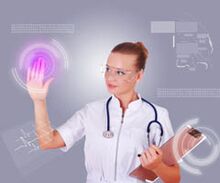
Translated from the Greek, the word "chondrose" can be translated by "cartilage".However, as a rule, the word "osteochondrosis" does not mean any damage to the cartilage fabric (which would be logical), but only diseases of the spine of cartilage.
In patients with osteochondrosis, the structure (and therefore, the function) of intervertebral discs - special cartilaginous structures, ensuring the mobility and flexibility of the human spine.
As the disease progresses, irreversible changes occur and also develop in the vertebrae themselves.
The causes of osteochondrosis
All the reasons why a person has a disease such as osteochondrosis, specialists divide into endogenous (or internal) and exogenous (or, consequently, external).
The endogenous (internal) causes are considered to be disorders of the spine that appeared in a person in the uterus, as well as age -related changes in cartilage and hereditary predisposition to osteochondrosis.
The main exogenous (external) experts take into account the incorrect distribution of the load which reaches the spine.It is such a distribution that causes changes that occur with cartilage in places where the greatest excessive pressure is.
In addition, the causes of the development of osteochondrosis are a trauma of the spine and a variety of infections, incorrect posture and poor posture, weakness of the back muscles and a lateral curvature (s) of the vertebral column.In addition, the negative consequences for the spine can have weight weights or a prolonged stay in an uncomfortable or unnatural position.
Unlike popular belief, not only people of mental work and those who do not follow their posture can suffer (and suffer) from osteochondrosis.This tormented disease even those who are well prepared physically.For example, movers, drivers and professional athletes.
In addition to the causes of purely mechanical property, metabolism problems (for the most part, calcium and phosphorus), as well as a deficiency in trace elements and vitamins (in particular magnesium, manganese, zinc and vitamin D) can lead to the appearance and development of osteochondrosis.Many doctors are sure that an inherited predisposition to osteochondrosis also plays an important role in the occurrence of the disease.
What's going on with osteochondrosis?
When a person throws heavy, jumps or falls, is often in an uncomfortable position, and so on, the intervertebral discs receive microtraume.If such injuries occur more or less often, over time, the discs lose their elasticity and expand, and at the same time, the distance between the vertebrae decreases.Consequently, there is a compression of the nerve roots extending from the spinal cord.This is what causes back pain.At the same time, at the very place where the nervousvascular beam is pushed, edema is formed - a result, the load on the same beam increases and the pain is intensifying.
When the destruction of the intervertebral disc has already started, it stops playing the role of the shock absorber, more and more injuries.Over time, a person's spine loses its natural flexibility.
How does osteochondrosis manifest?
The main manifestation of osteochondrosis is back pain.From which the intervertebral discs are damaged, the patient feels different pain.He can hurt his back not only, but also his neck, or perhaps a hand or a heart.Sometimes osteochondrosis even gives in the chest.A person can easily decide that something was going on with their heart, but in fact it was one of the nerves.In addition to pain, a person often feels muscle and overexploiting.Headaches, nausea, vomiting, ears in the ears, dizziness and doubles in the eyes, as well as cases of fainting, may indicate that blood vessels are pressed which transport blood to the brain.
Diagnosis for osteochondrosis
If one of the symptoms described above is manifested in you, it is an opportunity to request a consultation with a traumatologist or a neurologist.One of these experts will examine the spine and study brain traffic.If the doctor judges him necessary, he can send you to an x -ray or to prescribe a computer or a magnetic resonance (MRI) tomography of the spine that disturbs you.
Treatment of osteochondrosis
Prepare to allocate a lot of time for treatment with osteochondrosis.In addition, you will need your will.There are a fairly high number of ways to fight osteochondrosis.These are methods of medication, traction, massage, therapeutic gymnastics and needle-flexotherapy.In addition, manual therapists have their own methods - in some cases, they are the ones who have great efficiency.Rich medicine is also rich in ideas, offering to treat osteochondrosis with bee poison, massage and many other miraculous methods.If osteochondrosis has a complication in the form of an intervertebral disks hernia, alas, you cannot do without surgery - you need an operation.
Prevention of osteochondrosis
This is what profile doctors generally recommend in order to prevent radicult and osteochondrosis:
- Over time, adjust the curvature of the spine, as well as posture disorders.It is particularly necessary to pay attention to this article to the parents of schoolchildren.
- Regularly do sports and physical education.Thanks to sports charges, the SOP muscle corset is formed.Muscles - They will make your posture much more effectively than on a variety of wooden standing and seats with a straight back.In addition, your own muscles will protect the spine even when you forget.
- Try to eat well, join a diet.Follow the presence in your supply of products with a high content of vitamins, calcium and magnesium (they are abundantly present in fish and other seafood, spinach, cabbage, nuts and seeds, beans and peas, fresh milk and pregnancy bread).
- Do not leave the appearance of an excess weight.The extra pounds are an unnecessary load on your spine.
- Take gravity, distribute the loads on both hands as uniformly as possible.If possible, use backpacks, not bags.If you need to raise something very difficult, get up on your feet, not on the spine, look at how the Broatists do.























